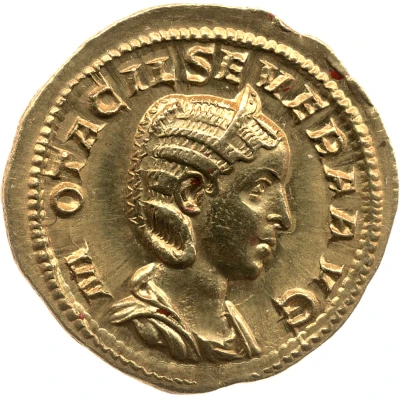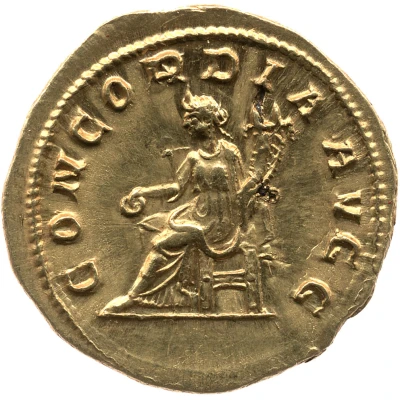Aureus - Philippus I FORTVNA REDVX; Fortuna
| Gold | - | - |
| Issuer | Rome › Roman Empire (27 BC - 395 AD) |
|---|---|
| Emperor | Philip I (Marcus Iulius Philippus) (244-249) |
| Type | Standard circulation coin |
| Years | 247-249 |
| Value | Aureus (25⁄2) |
| Currency | Antoninianus, Reform of Caracalla (AD 215 – 301) |
| Composition | Gold |
| Shape | Round (irregular) |
| Technique | Hammered |
| Demonetized | Yes |
| Updated | 2024-10-05 |
| Numista | N#282139 |
|---|---|
| Rarity index | 100% |
Reverse
Fortuna, draped, seated left, holding rudder in right hand and cornucopiae in left hand; wheel below seat.
Script: Latin
Lettering: FORTVNA REDVX
Translation:
Fortuna Redux.
Fortune that brings back [the Emperor in safety].
Comment
Source:Online Coins of the Roman Empire (OCRE)
Interesting fact
The Aureus - Philippus I (FORTVNA REDVX; Fortuna) coin was minted during the reign of Emperor Philip I, also known as Philip the Arab, who ruled the Roman Empire from 244 to 249 AD. The coin features an image of Fortuna, the Roman goddess of luck and prosperity, on one side, and an image of the emperor on the other. The coin was made of gold, which was a valuable and prestigious metal at the time, and was used as a symbol of the empire's wealth and power. It's interesting to note that the coin's design and imagery reflect the cultural and religious beliefs of the Roman Empire during this period. The worship of Fortuna was widespread in ancient Rome, and the goddess was often depicted as a symbol of good fortune and prosperity. The inclusion of Fortuna on the coin suggests that the emperor and the Roman Empire placed great importance on the idea of luck and prosperity, and saw it as a way to promote their power and influence. Overall, the Aureus - Philippus I (FORTVNA REDVX; Fortuna) coin is a fascinating piece of history that provides insight into the cultural and religious beliefs of the Roman Empire during the 3rd century AD.

